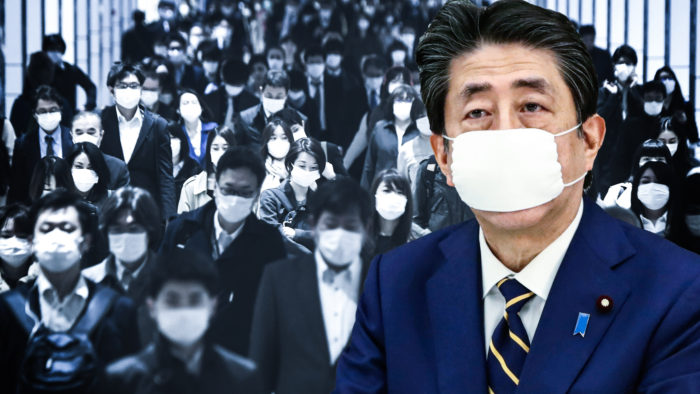Published in the Nikkei Asian Review 13/5/2020
The other day a present from Japanese Prime Minister Shinzo Abe slid into my mail-box. I was not the only recipient. Every household in Japan got a similar packet containing two white washable face-masks.
Abe’s gesture was not universally appreciated. There was mockery on social media. Political embarrassment followed when some of the first batch of masks proved defective. The larger point, though, is that Abe had seen that face-masks had become well-nigh unobtainable and knew that was politically unacceptable. In a health crisis involving air-borne germs or pollutants, the Japanese public has come to demand and expect masks.
Over the past 30 years, Japan has been a huge consumer of face-masks, with annual sales of over five billion pieces in pre-coronavirus times. The phenomenon even became an object of research by foreign sociologists. A 2012 study, making use of a ‘Foucauldian perspective’, noted that “in foreign eyes, mask-wearing appears to be a unique and curious practice particular to Japan. Its only well-known wearer in the developed world was the late Michael Jackson, identifying the practice with eccentric hypochondria.”
Another scholar declared mask-wearing to be ‘a disciplinary device in neo-liberal politics’ caused by Japan’s changing economic structure.
Well, it seems we are all neo-liberals now. Today almost all countries seriously hit by the coronavirus have become heavy users of masks – if, that is, they can get hold of them. What now looks “curious” are clips of US President Donald Trump or Vice President Mike Pence not wearing masks in situations where everyone else does. In some non-Asian countries such as Austria, the Czech Republic, Belgium and Israel, masking up has become a legal requirement.
So it is that masks – extremely low value added items in economic terms – have become symbols of the growing tension between globalization and national security. Over 70% of masks used in the U.S. come from China, a state of affairs that is no longer acceptable. As. Trade Representative Robert Lighthizer told a G 20 meeting last month “overdependence on other countries as a source of cheap medical products and supplies has created a strategic vulnerability for our economy.”
Japan, which had migrated most of its mask manufacture to Chinese plants, has already reacted. Venerable consumer goods maker Iris Ohmaya is taking advantage of Abe’s recently announced subsidies for companies moving operations out of China. From this summer it will churn out masks in its north Japan home base, at the rate of 150 million pieces per month.
Japan was not the first country in which the public made prophylactic use of face-masks. During the deadly Spanish Influenza pandemic of 1918-20, several U.S. cities, such as San Francisco, made mask-wearing in public gatherings obligatory. According to Nancy Tomes, a historian at Stoney Brook University, “Mask wearing gained considerable popularity as an emblem of public spiritedness and discipline… Fashionable women made theirs of chiffon.” That sounds like Japan today, down to the fashion masks you see in trendier parts of Tokyo.
Although some accounts credited masks with reducing infections in the US, the case was not proven and the practice was abandoned for the next hundred years. In Japan, though, it was a different story. Mask-wearing had been introduced as a modern medical practice that would help contain the Spanish Flu. It was strongly recommended to the public by the government and press. For police and soldiers and in the colonial possessions of Korea and Taiwan it was compulsory. Masks were also distributed free to marginalized groups and the poor.
When further flu outbreaks occurred in 1934, 1949 and 1957, the Japanese public reached for their masks. Other reasons appeared too. Air pollution was a huge problem in the 1960s, and has reappeared with regular dousings of “yellow sand” and particle-laden smog blown over from China. Then there is the “national illness” of hay-fever, caused by the mass planting of cedar trees in the Japan Alps. From the 1980s onward, clouds of headache-inducing, throat-lacerating cedar pollen have descended on Tokyo early in the year. As a sufferer from pollen allergy, I never bought the idea that mask-wearing was some bizarre Japanese ritual. It was just common sense.
Masks are also social signals, showing that you are part of the team; that you care about your own and others’ health. In a pandemic, such solidarity is vital. But do masks offer protection against viruses? In pre-coronavirus times, informed opinion – at the World Health Organization and America’s Centers for Disease Control and Prevention – was skeptical. Now, though, the experts have changed their tune. A UK government advisory states that face-masks are at least half as effective as medical masks and recommends they become standard safety equipment, like seatbelts and cycling helmets.
Several other European governments plan to use them as part of their strategies for re-opening their economies. Let’s hope that proceeds smoothly. As an experience, being masked up definitely beats being locked down.

